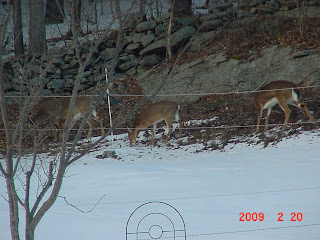

As I said before, the land is heavily forested Northern New England hardwood/softwood mix. One hundred foot White Pines and Red Oaks along with Sugar Maple predominate the landscape. Hemlock stands provide ample winter cover for the deer. Our camp sits in the saddle of a (long, you guessed it) high ridge at about a thousand feet above sea level. The saddle is pronouced enough that migrating Canada Geese pass through it. On certain stands, you are actually eye to eye level with them, and can hear the clicking of their feathers as they stroke through. Once it was foggy and I was in the Tall Stand when a flock of about forty winged through. I thought they were going to run right into me, but didn't. Our land is 130 acres, but is surrounded by about 5000 undeveloped and fairly safe acres that has little hunting pressure. We habitually hunt about a third of the entire area, with most success within 3/4 mile of camp. Many deer have been taken within sight (several hundred yards) of camp porch. A walking/ATV trail winds roughly around the borders of our land, and there are several interior trails for still hunting. We used to ban ATV's from the trails except for retrieval of deer, but eventually learned that ATVing to areas to hunt disturbed the deer less than walking there. I have a favorite stand way up on the Far Ridge about a mile from camp and I routinely ride my ATV up within a 100 yards of that stand. I have arrowed some fine deer there. Most of the hunters here walk/still hunt to their stands anyway, and in a way that is more fair chase I suppose. In any case, when we do get one, we seldom have to drag a deer more than a hundred yards before we can sled it out behind a machine. Below is an entry and a typical one, taken from my 2004 journal I keep on the seasons.
"Nov. 17th, a big ground scrape is found at the Far Ridge . We hunt the area, no luck...only animal seen is a whitish coyote 100 yards from camp..on the 20th, I am returning to camp at midday on an ATV and pass a small Christmas tree plantation seventy-five yards from deer camp porch. I find a fresh tree rub that was not there the day before... the tree is big, and so is he. The damage is heavy and we are fired by the discovery that a large buck visits camp at night. Teasing us. November 21st, two deer jumped at Walker's field - no shot. Sunday at noon and most hunters head out for home, three remain at camp. One elects to go to Walker's fields - jumps two deer, but unknown sex and no shot taken. I take the Far Stand for a late afternoon sit. The last hunter in camp, a Long Ridge veteran decides to hike out the West side trail. It's four P.M. and I am feeling good, a buck is nearby...the occasional honk of a passing goose, a low guttural call of a bird high in the trees that I have never been able to identify in fifty years, and life is good. It is calm. 4:01 PM, terrific view of the Far Field, no wind, and I have THAT feeling. POW! - the shot comes from the Southwest, about a quarter mile to my left. I know immediately who it is, and where the hunter is. I reach for my radio, and flick it on... "Yeah, Jack, that was me, I got a hit, might as well sit tight until I check it out." Right. I am as a brother to this fellow SWAT Team member, and I know his skills. I heard his shot, and it is as good as done for me. "10-4" I answer, but I am already unsnapping my safety harness twenty-five feet above the ground. I have my rifle slung, my waist pack on and poised in ten seconds. Down I go, and as I hit the ground, I hear the radio crackle - "Jack, better get one of the ATV's up here, he's down, I'll leave my hat in the trail where I head West". I am already half way to camp, and my radio crackles from our third hunter, who has monitored and is on his way to help. Back at camp, start an ATV, load rope, extra knives, a towel, camera, and head out the West trail. At the moment I see the orange cap in the middle of the trail I glance west and see bright orange in the thickening gloom. Forty yards from the trail, this buck was heading south, parallel to the trail, when he was spotted, and shot. With a shattered heart, broken leg, and smashed ribs, this nine point beauty above managed to streak forty yards before piling up. Dead before his first leap, this buck had such a will to live, that he galloped without consciousness.
We took time to admire his coat, and his swollen neck, and his rack . Silently I said the ancient German prayer .. ‘…and we thank thee for thy beauty, speed and grace...’ By the time he was weighed, and photographed hanging in camp, on the weigh scale, next to hunters, it was late, and way past dark. Several toasts and promises later, I stood alone at deer camp. Pitch black I step off the porch to the fireplace. The fire just red embers, and all hunters gone until the last weekend of the season. The high of the hunt - the loneliness of it's end....there is NOTHING that can match either."





